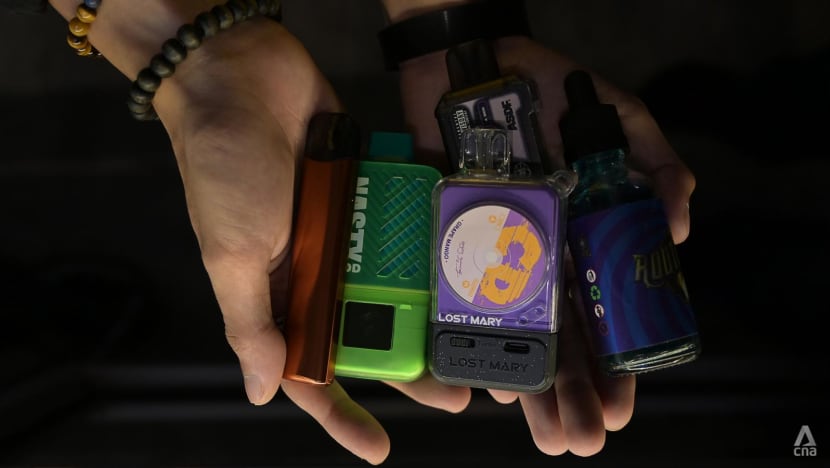Commentary: Kpods are in the headlines, but vaping was always the crisis
When one product becomes the face of the problem, there’s a risk that others fade into the background, say Yvette van der Eijk and Jared Ng from NUS.

A variety of disposable vape devices are displayed at a shop in Johor Bahru, Malaysia on Nov 26, 2024. (Photo: CNA/Zamzahuri Abas)

This audio is generated by an AI tool.
SINGAPORE: In recent months, Kpods - vape devices laced with an anaesthetic called etomidate - have dominated headlines in Singapore and around the world.
Many of us have come across stories about teenagers turning into “zombies” and behaving erratically. Parents have recounted tragic experiences of their children’s addiction struggles. There have been calls for stricter regulations around the accessibility of Kpods, especially for young people.
This has drawn increased public attention to the dangers of vaping, and rightfully so. But amid this intense focus on Kpods, it’s worth considering if something larger is being overlooked. That is, the broader issue of vaping itself, which paved the way for Kpods in the first place.
When one product becomes the face of the problem, there’s a risk that others fade into the background. It is not hard to imagine how a young person might view Kpods as the extreme, and “normal” vapes as an acceptable compromise.
This division, whether conscious or subconscious, risks blunting the urgency around the vaping epidemic as a whole.
STUDENTS USING AND SELLING VAPES
Although vaping has always been banned in Singapore, products are still smuggled in. Despite tight border controls and stringent laws, the number of vaping offences has steadily increased.
In the first half of 2025, more than 2,500 reports of vaping were made, nearly matching the full-year total of over 3,000 such incidents in 2024.
Schools are reporting more students caught with vapes. Some teenagers are now not just users, but also sellers. Just last week (Jul 25), two teenagers approached a Primary 4 student from Fairfield Methodist School as he was walking home from school and tried to get him to buy a vape.
In a separate case, a 15-year-old boy who was caught with vapes five times over a 10-month period was recently ordered by a court to be placed in a boys' home.
In yet another case, a man was charged in July for manufacturing Kpods at home, the first case of its kind in Singapore. Police found 569 empty pod casings, 1,485 pod covers, 100 loose vape pods and disposable vapes in an HDB flat.
The scale of the problem suggests a deeper issue than just breaking the law: Demand is growing, and supply chains are adapting.
HEFTIER PENALTIES ARE ONLY PART OF THE SOLUTION
Law enforcement has moved quickly. Singapore’s plan to list etomidate as a Class C drug under the Misuse of Drugs Act is a necessary step. It gives law enforcement stronger grounds to impose heftier penalties for Kpod offences. But this is a game of whack-a-mole.
A major driver of the Kpod scourge is relentless marketing on social media platforms such as Telegram. Vapes are aggressively marketed as trendy, harmless consumer products. While improving drug enforcement laws is important to stay ahead of these schemes, enforcement alone may not be enough.
Part of the challenge lies in how vapes are distributed. They are small, easy to hide and hard to trace. Many are distributed through encrypted messaging apps, peer-to-peer networks, and even unwitting parents returning from overseas trips.
This is why another layer is needed: One that educates people on the dangers of vaping and helps them take ownership of their well-being.
One recent example is the vape bin initiative, which encourages users to surrender their vapes without fear of punishment. The idea is simple: Get harmful devices off the streets and into bins.
Critics have asked why a vape user would not just toss the device down the rubbish chute if he or she truly wanted to quit vaping.
Whether the vape is thrown into a rubbish chute or a vape bin is not the point. These initiatives are about fostering community cooperation. About telling people that there is no shame in their past actions and offering a public, deliberate first step to quit vaping.

But these efforts can only succeed if backed by support structures such as public education, counselling and addiction recovery services.
Teens who are vaping to cope with mental health issues, academic stress or social pressure are likely to respond more favourably to counselling and other rehabilitative programmes than the stick.
It is worth noting that a similar, albeit smaller, initiative was launched in November 2023 by the MacPherson Youth Network and Bilby Community Development, calling for youths aged 12 to 30 to surrender their vapes to receive a S$30 gift voucher for shops like Decathlon and Sephora.
Whether such financial incentives are enough to motivate quitting is unclear. A more effective long-term approach would focus on helping vape-addicted youths address the underlying issues that compel them to vape in the first place.
THERE IS NO “SAFE” VAPE
As public discussions on Kpods continue, it is important to remember this: All forms of vaping come with serious health risks. There is no “safe” vape.
The authorities are rightly cracking down on Kpods, but that attention should serve to open up the conversation, not narrow it.
Kpods may be the latest concern, but they are part of a much larger and evolving landscape. The more we talk openly about the risks, the more we can prevent harm before it starts.
Yvette van der Eijk is Assistant Professor at the Saw Swee Hock School of Public Health, National University of Singapore. Jared Ng is Communications Manager at the Institute for the Public Understanding of Risk, National University of Singapore.


















